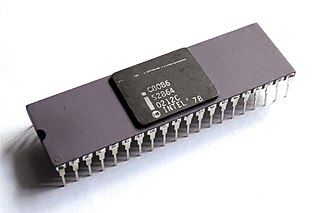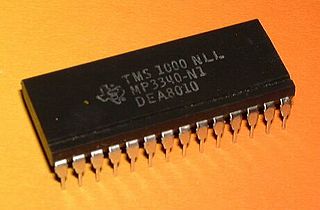A control store is the part of a CPU's control unit that stores the CPU's microprogram. It is usually accessed by a microsequencer. A control store implementation whose contents are unalterable is known as a Read Only Memory (ROM) or Read Only Storage (ROS); one whose contents are alterable is known as a Writable Control Store (WCS).

The 8086 is a 16-bit microprocessor chip designed by Intel between early 1976 and June 8, 1978, when it was released. The Intel 8088, released July 1, 1979, is a slightly modified chip with an external 8-bit data bus, and is notable as the processor used in the original IBM PC design.

The Intel 486, officially named i486 and also known as 80486, is a microprocessor introduced in 1989. It is a higher-performance follow-up to the Intel 386. It represents the fourth generation of binary compatible CPUs following the 8086 of 1978, the Intel 80286 of 1982, and 1985's i386.

A microprocessor is a computer processor for which the data processing logic and control is included on a single integrated circuit (IC), or a small number of ICs. The microprocessor contains the arithmetic, logic, and control circuitry required to perform the functions of a computer's central processing unit (CPU). The IC is capable of interpreting and executing program instructions and performing arithmetic operations. The microprocessor is a multipurpose, clock-driven, register-based, digital integrated circuit that accepts binary data as input, processes it according to instructions stored in its memory, and provides results as output. Microprocessors contain both combinational logic and sequential digital logic, and operate on numbers and symbols represented in the binary number system.
In processor design, microcode serves as an intermediary layer situated between the central processing unit (CPU) hardware and the programmer-visible instruction set architecture of a computer, also known as its machine code. It consists of a set of hardware-level instructions that implement the higher-level machine code instructions or control internal finite-state machine sequencing in many digital processing components. While microcode is utilized in Intel and AMD general-purpose CPUs in contemporary desktops and laptops, it functions only as a fallback path for scenarios that the faster hardwired control unit is unable to manage.

The 6800 is an 8-bit microprocessor designed and first manufactured by Motorola in 1974. The MC6800 microprocessor was part of the M6800 Microcomputer System that also included serial and parallel interface ICs, RAM, ROM and other support chips. A significant design feature was that the M6800 family of ICs required only a single five-volt power supply at a time when most other microprocessors required three voltages. The M6800 Microcomputer System was announced in March 1974 and was in full production by the end of that year.

The Pentium is a microprocessor introduced by Intel on March 22, 1993. It is the first CPU using the Pentium brand. Considered the fifth generation in the x86 (8086) compatible line of processors, succeeding the i486, its implementation and microarchitecture was internally called P5.

In electronics and computer science, a reduced instruction set computer (RISC) is a computer architecture designed to simplify the individual instructions given to the computer to accomplish tasks. Compared to the instructions given to a complex instruction set computer (CISC), a RISC computer might require more instructions in order to accomplish a task because the individual instructions are written in simpler code. The goal is to offset the need to process more instructions by increasing the speed of each instruction, in particular by implementing an instruction pipeline, which may be simpler to achieve given simpler instructions.

A superscalar processor is a CPU that implements a form of parallelism called instruction-level parallelism within a single processor. In contrast to a scalar processor, which can execute at most one single instruction per clock cycle, a superscalar processor can execute or start executing more than one instruction during a clock cycle by simultaneously dispatching multiple instructions to different execution units on the processor. It therefore allows more throughput than would otherwise be possible at a given clock rate. Each execution unit is not a separate processor, but an execution resource within a single CPU such as an arithmetic logic unit.
Reconfigurable computing is a computer architecture combining some of the flexibility of software with the high performance of hardware by processing with flexible hardware platforms like field-programmable gate arrays (FPGAs). The principal difference when compared to using ordinary microprocessors is the ability to add custom computational blocks using FPGAs. On the other hand, the main difference from custom hardware, i.e. application-specific integrated circuits (ASICs) is the possibility to adapt the hardware during runtime by "loading" a new circuit on the reconfigurable fabric, thus providing new computational blocks without the need to manufacture and add new chips to the existing system.
In computer engineering, out-of-order execution is a paradigm used in high-performance central processing units to make use of instruction cycles that would otherwise be wasted. In this paradigm, a processor executes instructions in an order governed by the availability of input data and execution units, rather than by their original order in a program. In doing so, the processor can avoid being idle while waiting for the preceding instruction to complete and can, in the meantime, process the next instructions that are able to run immediately and independently.
Bit slicing is a technique for constructing a processor from modules of processors of smaller bit width, for the purpose of increasing the word length; in theory to make an arbitrary n-bit central processing unit (CPU). Each of these component modules processes one bit field or "slice" of an operand. The grouped processing components would then have the capability to process the chosen full word-length of a given software design.
MIPS, an acronym for Microprocessor without Interlocked Pipeline Stages, was a research project conducted by John L. Hennessy at Stanford University between 1981 and 1984. MIPS investigated a type of instruction set architecture (ISA) now called reduced instruction set computer (RISC), its implementation as a microprocessor with very large scale integration (VLSI) semiconductor technology, and the effective exploitation of RISC architectures with optimizing compilers. MIPS, together with the IBM 801 and Berkeley RISC, were the three research projects that pioneered and popularized RISC technology in the mid-1980s. In recognition of the impact MIPS made on computing, Hennessy was awarded the IEEE John von Neumann Medal in 2000 by the Institute of Electrical and Electronics Engineers (IEEE), the Eckert–Mauchly Award in 2001 by the Association for Computing Machinery, the Seymour Cray Computer Engineering Award in 2001 by the IEEE Computer Society, and, again with David Patterson, the Turing Award in 2017 by the ACM.
Alexander Reinefeld is a German computer scientist and games researcher. He is the head of computer science at Zuse Institute Berlin. His contributions to the field include the NegaScout algorithm.

The history of general-purpose CPUs is a continuation of the earlier history of computing hardware.
John Patrick Hayes is an Irish-American computer scientist and electrical engineer, the Claude E. Shannon Chair of Engineering Science at the University of Michigan. He supervised over 35 doctoral students, coauthored seven books and over 340 peer-reviewed publications. His Erdös number is 2.

Massoud Pedram is an Iranian American computer engineer noted for his research in green computing, energy storage systems, low-power electronics and design, electronic design automation and quantum computing. In the early 1990s, Pedram pioneered an approach to designing VLSI circuits that considered physical effects during logic synthesis. He named this approach layout-driven logic synthesis, which was subsequently called physical synthesis and incorporated into the standard EDA design flows. Pedram's early work on this subject became a significant prior art reference in a litigation between Synopsys Inc. and Magma Design Automation.
Lizy Kurian John is an Indian American electrical engineer, who is currently the Cullen Trust for Higher Education Endowed Professor in the Department of Electrical and Computer Engineering at the University of Texas at Austin. She received her Ph.D. in computer engineering from The Pennsylvania State University in 1993. She joined The University of Texas Austin faculty in 1996. Her research is in the areas of computer architecture, multicore processors, memory systems, performance evaluation and benchmarking, workload characterization, and reconfigurable computing.

Nader Bagherzadeh is a professor of computer engineering in the Department of Electrical Engineering and Computer Science at the University of California, Irvine, where he served as a chair from 1998 to 2003. Bagherzadeh has been involved in research and development in the areas of: Computer Architecture, Reconfigurable Computing, VLSI Chip Design, Network-on-Chip, 3D chips, Sensor Networks, Computer Graphics, Memory and Embedded Systems. Bagherzadeh was named Fellow of the Institute of Electrical and Electronics Engineers (IEEE) in 2014 for contributions to the design and analysis of coarse-grained reconfigurable processor architectures. Bagherzadeh has published more than 400 articles in peer-reviewed journals and conferences. He was with AT&T Bell Labs from 1980 to 1984.










